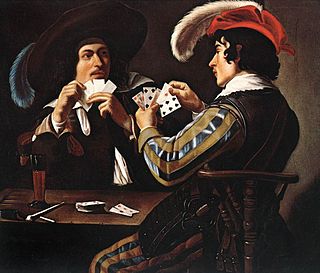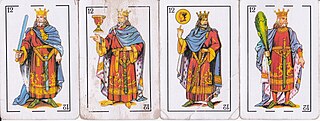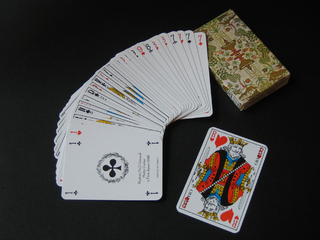
Burro (English: donkey) or los burros [1] is a card game played with Spanish playing cards. The principal objective of the game is to get four cards of the same number. The ideal number of players is from 4 to 8. [2]

Burro (English: donkey) or los burros [1] is a card game played with Spanish playing cards. The principal objective of the game is to get four cards of the same number. The ideal number of players is from 4 to 8. [2]
The objective of the game is to run out of cards as quickly as possible. Each time one of the players lose, they are assigned a letter of the word burro . The player who is first to complete the word becomes the ultimate loser of the game. The final winner will be the player who has failed to complete the word when others do. To win a game a player must place their hand face down in the middle of the table. [1]
There are several techniques used to win burro. One of them, called amago (English: hint) is to place a hand in the center of the table, saying a word other than burro. If a player puts their hand in the center, they will be assigned a letter. However, if no one puts their hand in the center, the letter will be assigned to the player who made the hint. Another technique would be feign putting one's hand down. [3]

Blackjack is a casino banking game. It is the most widely played casino banking game in the world. It uses decks of 52 cards and descends from a global family of casino banking games known as Twenty-One. This family of card games also includes the European games Vingt-et-Un and Pontoon, and the Russian game Ochko. Blackjack players do not compete against each other. The game is a comparing card game where each player competes against the dealer.

Contract bridge, or simply bridge, is a trick-taking card game using a standard 52-card deck. In its basic format, it is played by four players in two competing partnerships, with partners sitting opposite each other around a table. Millions of people play bridge worldwide in clubs, tournaments, online and with friends at home, making it one of the world's most popular card games, particularly among seniors. The World Bridge Federation (WBF) is the governing body for international competitive bridge, with numerous other bodies governing it at the regional level.

A card game is any game using playing cards as the primary device with which the game is played, be they traditional or game-specific. Countless card games exist, including families of related games. A small number of card games played with traditional decks have formally standardized rules with international tournaments being held, but most are folk games whose rules may vary by region, culture, location or from circle to circle.
Pai gow poker is a version of pai gow that is played with playing cards, instead of traditional pai gow's Chinese dominoes. The game of pai gow poker was created in 1985 in the United States by Sam Torosian, owner of the Bell Card Club.

Baccarat or baccara is a card game played at casinos. It is a comparing card game played between two hands, the "player" and the "banker". Each baccarat coup has three possible outcomes: "player", "banker", and "tie". There are three popular variants of the game: punto banco, baccarat chemin de fer, and baccarat banque. In punto banco, each player's moves are forced by the cards the player is dealt. In baccarat chemin de fer and baccarat banque, by contrast, both players can make choices. The winning odds are in favour of the bank, with a house edge of at least 1 percent.

Uno is an American shedding-type card game that is played with a specially printed deck. The game's general principles put it into the crazy eights family of card games, and it is similar to the traditional European game mau-mau.

Skat, historically Scat, is a three-player trick-taking card game of the Ace-Ten family, devised around 1810 in Altenburg in the Duchy of Saxe-Gotha-Altenburg. It is the national game of Germany and, along with Doppelkopf, it is the most popular card game in Germany and Silesia and one of the most popular in the rest of Poland. A variant of 19th-century Skat was once popular in the US. John McLeod considers it one of the best and most interesting card games for three players, and Kelbet described it as "the king of German card games."

Pig is a simple, collecting card game of early 20th century American origin suitable for three to thirteen players that is played with a 52-card French-suited pack. It has two very similar and well known variants – Donkey and Spoons. It is often classed as a children's game. It may be descended from an old game called Vive l'Amour.

Card counting is a blackjack strategy used to determine whether the player or the dealer has an advantage on the next hand. Card counters are advantage players who try to overcome the casino house edge by keeping a running count of high and low valued cards dealt. They generally bet more when they have an advantage and less when the dealer has an advantage. They also change playing decisions based on the composition of the deck.

Escoba is a Spanish variant of the Italian fishing card game Scopa, which means "broom", a name that refers to the situation in the game where all of the cards from the board are "swept" in one turn. The game is usually played with a deck of traditional Spanish playing cards, called naipes.

Rummy is a group of matching-card games notable for similar gameplay based on matching cards of the same rank or sequence and same suit. The basic goal in any form of rummy is to build melds which can be either sets or runs and either be first to go out or to amass more points than the opposition.

Preferans or Russian Preference is a 10-card plain-trick game with bidding, played by three or four players with a 32-card Piquet deck. It is a sophisticated variant of the Austrian game Préférence, which in turn descends from Spanish Ombre and French Boston. It is renowned in the card game world for its many complicated rules and insistence on strategical approaches.

Twenty-five is the Irish national card game, which also underlies the Canadian game of Forty-fives. Charles Cotton describes it in 1674 as "Five Fingers", a nickname applied to the Five of Trumps extracted from the fact that the Irish word cúig means both 'five' and 'trick'. It is supposed to be of great antiquity, and widely believed to have originated in Ireland, although "its venerable ancestor", Maw, of which James I of England was very fond, is a Scottish game.
Scrabble variants are games created by changing the normal Scrabble rules or equipment.

Brisca is a popular Spanish card game played by two teams of two with a 40-card Spanish-suited pack or two teams of three using a 48-card pack.

Tarneeb, also spelled tarnibe and tarnib, and called hakam in the Persian Gulf region, is a plain trick-taking card game played in various Middle Eastern countries, most notably in the countries of the Levant, and Tanzania. The game may be considered a variation of Whist, or a version of Spades.

Manille is a Catalan French trick-taking card game which uses a 32 card deck. It spread to the rest of France in the early 20th century, but was subsequently checked and reversed by the expansion of Belote. It is still popular in France and the western part of Belgium.

Commerce is an 18th-century gambling French card game akin to Thirty-one and perhaps ancestral to Whisky Poker and Bastard Brag. It aggregates a variety of games with the same game mechanics. Trade and Barter, the English equivalent, has the same combinations, but a different way of acquiring them. Trentuno, Trent-et-Uno, applies basically to the same method of play, but also has slightly different combinations. Its rules are recorded as early as 1769.
Schlafmütze ("nightcap") is a fast-paced game of matching and bluffing, which is closely related to the English game Spoons. The game requires a minimum of two players, but ideally a minimum of three players, and involves each player passing round cards in an attempt to acquire a hand consisting of all the same value cards. Upon doing so, they silently place their hand of cards on the table. The last player to notice that this has happened is the loser of the round.

Codenames is a 2015 party card game designed by Vlaada Chvátil and published by Czech Games Edition. Two teams compete by each having a "spymaster" give one-word clues that can point to multiple words on the board. The other players on the team attempt to guess their team's words while avoiding the words of the other team. Codenames received positive reviews and won the 2016 Spiel des Jahres award for the best board game of the year.